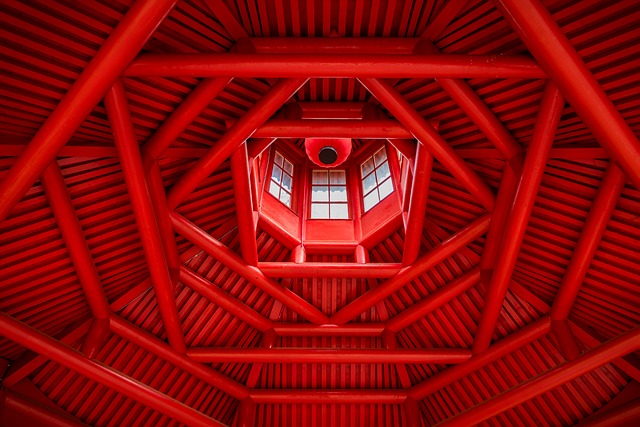Prefab roof installation services are pivotal in achieving energy efficiency and comfort in modular buildings. These services offer pre-engineered systems with advanced materials like high-R value foam or fiberglass to seal gaps and reduce thermal bridges, catering to diverse microclimates. Custom designs integrate eco-friendly materials while meeting strict energy codes, ensuring durability against varied weather conditions. Advanced ventilation features, such as ridge vents and power ventilators, regulate temperature and humidity, reducing HVAC system load. These solutions enhance occupant comfort and energy efficiency, aligning with sustainable building practices for both residential and commercial applications. Choosing durable materials like metal or advanced synthetic options, along with strategic airflow designs, ensures roof longevity and building sustainability.
In the realm of modern construction, prefab structures are revolutionizing the building industry with their efficiency and cost-effectiveness. However, ensuring optimal insulation and ventilation is paramount for these modular buildings to achieve energy efficiency and comfort. This article explores the essential aspects of prefab roofing, including understanding specific insulation needs, implementing effective ventilation strategies, and leveraging prefab roof installation services. We also delve into eco-friendly and custom roofing options, providing a comprehensive guide for successful prefab roofing solutions.
Understanding Insulation Needs for Prefab Structures
In the realm of prefab construction, understanding insulation needs is paramount for achieving energy efficiency and occupant comfort. Unlike traditional building methods, prefab structures demand tailored insulation solutions that cater to their unique characteristics—such as modularity, quick assembly, and often, diverse microclimates. The primary goal is to create a sealed envelope that prevents heat transfer, ensuring consistent interior temperatures year-round.
Prefab roof installation services play a pivotal role in achieving this, offering pre-engineered roof systems designed for optimal performance. These include advanced insulation materials, like high-R value foam or fiberglass, strategically placed to seal gaps and reduce thermal bridges. For commercial prefab roof installation, custom prefab roof designs are often the norm, integrating eco-friendly materials while adhering to strict energy codes. Moreover, these systems must withstand varied weather conditions, from moist environments to harsh winters, making durable and weatherproof solutions essential.
Ventilation Strategies in Modular Building Design
In modular building design, proper ventilation is key to creating comfortable and healthy indoor environments. Prefab roofing solutions offer unique opportunities for optimized airflow, leveraging advanced materials and pre-engineered roof systems. Incorporating features like ridge vents, static vents, and power ventilators helps regulate temperature and humidity levels, reducing the load on HVAC systems. For commercial prefab roofs, these ventilation strategies not only enhance occupant comfort but also contribute to energy efficiency, a critical aspect for sustainable building practices.
Custom prefab roof designs can further tailor ventilation systems to specific needs. Eco-friendly prefab roofs, for instance, may integrate green roofing elements that improve insulation and support local ecosystems. By combining efficient ventilation with innovative roof installation services, modular buildings can offer unparalleled comfort and performance, catering to both residential and commercial applications.
The Role of Prefab Roof Installation Services
Prefab roof installation services play a pivotal role in enhancing the insulation and ventilation capabilities of prefab structures. These specialized services offer an array of pre-engineered roof systems tailored to suit various architectural needs, from residential to commercial spaces. By integrating advanced modular roofing solutions, professionals ensure that prefab homes or buildings are equipped with efficient, eco-friendly prefab roofs.
The expertise involved in these installations is crucial for achieving optimal performance. Custom prefab roof designs, for instance, can be crafted to balance aesthetic appeal with functional benefits. This involves strategic placement of ventilation channels and insulation materials, ensuring a comfortable indoor environment while promoting energy efficiency. Thus, commercial prefab roof installation or residential applications benefit from enhanced structural integrity and longevity through these specialized services.
Exploring Eco-Friendly and Custom Roofing Options
When it comes to prefab design, the roof is a key component that can greatly impact energy efficiency and sustainability. Exploring eco-friendly and custom roofing options offers a perfect blend of functionality and environmental responsibility. Prefab roof installation services provide an array of prefab roofing solutions tailored to specific needs, including modular roof installation and pre-engineered roof systems. These innovative options are particularly advantageous for both residential and commercial prefab roof installations, ensuring optimal insulation and ventilation.
Eco-friendly prefab roofs incorporate materials that are not only sustainable but also durable. Custom prefab roof designs allow homeowners and businesses to add a unique aesthetic touch while maintaining the structural integrity required for various climates. By choosing these options, you contribute to a reduced carbon footprint while enjoying enhanced energy performance in your prefab home or building.
Ensuring Longevity: Best Practices for Prefab Roofing Solutions
Ensuring the longevity of a structure is paramount when it comes to prefab roofing solutions. Prefab roof installation services offer an efficient and cost-effective way to protect buildings, but proper maintenance and design considerations are key to their durability. Best practices involve selecting high-quality materials that meet or exceed industry standards for both prefab roofing systems and modular roof installations. These include durable, weather-resistant options like metal or advanced synthetic materials.
When designing eco-friendly prefab roofs for homes or commercial spaces, integrating smart ventilation systems is crucial. Proper ventilation not only enhances energy efficiency by reducing heat buildup but also mitigates moisture issues that can lead to structural damage over time. Custom prefab roof designs should incorporate strategic airflow, ensuring a balanced exchange of indoor and outdoor air. This not only prolongs the life of the roof but also contributes to overall building sustainability.
In conclusion, proper insulation and ventilation are paramount in prefab design to ensure comfort, durability, and sustainability. By understanding specific insulation needs, implementing effective ventilation strategies, and leveraging professional prefab roof installation services, builders can deliver high-quality, eco-friendly prefab roofing solutions that meet the demands of both residential and commercial projects. Custom prefab roof designs offer an added touch, allowing for unique aesthetics and enhanced structural integrity.
